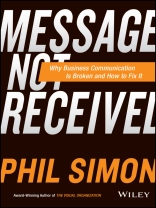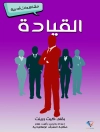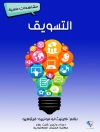Get your message across the right way with clear communication
Message Not Received provides the tools and techniques that make an effective writer and public speaker. Particularly on topics related to data and technology, effective communication can present a challenge in business settings. This book shows readers how those challenges can be overcome, and how to keep the message from getting lost in the face of mismatched levels of knowledge, various delivery media, and the library of jargon that too often serves as a substitute for real, meaningful language. Coverage includes idea crystallization, the rapidly changing business environment, Kurzweil’s law of accelerating change, and our increasing inability to understand what we are saying to each other. Rich with visuals including diagrams, slides, graphs, charts, and infographics, this guide provides accessible information and actionable guidance toward more effectively conveying the message.
Today, few professionals can ignore the tsunami of technology that permeates their lives, advancing far more rapidly that most of us can handle. As a result, too many people think that successful speaking means using buzzwords, jargon, and invented words that sound professional, but don’t actually communicate meaning. This book provides a path through the noise, helping readers get their message across succinctly, efficiently, and effectively.
* Adapt your approach for more effective communication
* Learn the critical skill of crystallizing ideas
* Tailor your style to the method of delivery
* Ensure that your message is heard, understood, and internalized
It doesn’t matter whether you’re pitching to a venture capitalist, explaining daily challenges to a non-tech manager, or speaking to hundreds of people – jargon-filled word salad uses a lot of words to say very little. Better communication requires a different approach, and Message Not Received gives you a roadmap to more effective speaking and writing for any audience or medium.
Mục lục
List of Figures and Tables xv
Preface xvii
Part I Worlds Are Colliding
Introduction: The Intersection of Business, Language, Communication, and Technology 3
Subject: The Other Scourge of Business Communication 5
Technology and the Cardinal Importance of Business Communication 5
What’s the Big Whoop? 6
From Pencils to Whats App: A Little History Lesson 7
Book Overview and Outline 8
My Communication Bona Fides 17
Next 19
1 Technology Is Eating the World: The Dizzying Nature of Today’s Existence 21
Whoops 22
Accelerating Technological Change 25
The Rise of the Machines 28
Trailing the Goldfish: Our Declining Attention Spans 30
A Communications Revolution 31
The Age of the Entrepreneur 32
Disruption Is Cool 34
SEO, and the Really Long Tail 35
The Sliding Scale of Search 37
Google and the Never-Ending Jargon Train 40
Marketing Madness 41
Mobile Mania 44
BYOD 44
The Rise of the Tech Celebrity 45
A New Body Politic 46
Other Trends 47
Next 48
Notes 48
2 The Increasingly Overwhelmed Employee: Is This Becoming the New Normal? 51
Mad Men No More 52
Abundant Leisure: Keynes Was Wrong 56
Drowning in Data 57
Demonizing the Tech Companies 59
The Limits of Technology’s Tentacles 60
A Different Kind of Workplace 61
Is Being Overwhelmed Even a Choice Anymore? 64
Next 69
Notes 70
Part II Didn’t You Get That Memo?: Why We Don’t Communicate Good at Work
3 What We Say: Examining Words at Work 73
Jargon: The Cause of So Much Noise 75
Beyond Jargon: Other Communication and Language Atrocities 90
Next 93
Notes 93
Appendix to Chapter 3 95
Note 98
Part III Message Received
4 How We Say It: E-Mail Is Dead. Long Live E-Mail! 99
A Communications Dynasty: Explaining E-Mail’s Impressive Reign 102
E-Mail Nation 112
How We’re Working Isn’t Working 114
Next 125
Notes 125
5 Why Bad Communication Is Bad Business: The Unintended Consequences of Mixed and Missed Messages 127
One Size Does Not Misfit All 129
Message Not Received 130
Decreased Clarity, Credibility, and Trust 131
Lost Sales 131
Severed Relationships and Burnt Bridges 132
Poor Execution and Strategic Blunders 135
Lower Productivity 137
Inefficiency, Waste, and Severed Relationships 138
Increased Risk of Project Failure 139
Other Long-Term Employee Issues 141
Net Effect: A Vicious Cycle 142
Next 142
Notes 142
6 Don’t Call It a Paradigm: Guidelines for Effective Business Communication 145
Language 147
E-Mail 148
Selecting a Communications Medium 150
Handling the Fallout 150
Next 151
Notes 151
7 Words and Context: Building a Solid Communication Foundation 153
A Trip Down Memory Lane 154
The World of Words 155
Communication Context, Awareness, and Technique 165
Next 174
Notes 175
8 Life Beyond E-Mail: How Progressive Organizations Are Using New Tools to Enable More Effective Collaboration and Communication 177
Communication and Collaboration Circa 2004 178
The Benefits of Old Tools 181
E-Mail Detox 182
If Not E-Mail, Then What? 184
True Communication and Collaboration in Action 187
Slaying the E-Mail Dragon: Klick Health 187
Keep Calm and Jive On 198
The Internal Social Network 204
New Tools: No Guarantees 210
Next 211
Notes 212
Part IV What Now? Coda: Was This Message Received? 215
Acknowledgments 219
Thank You 221
Selected Bibliography 223
About the Author 227
Index 229
Giới thiệu về tác giả
PHIL SIMON is a frequent keynote speaker and recognized technology authority. He is the award-winning author of six previous management books, including the award-winning The Age of the Platform. While not speaking and writing, he advises organizations on matters related to communication strategy, data, and technology. His contributions have been featured in the Harvard Business Review, CNN, Wired, the New York Times, NBC, CNBC, Inc. magazine, Business Week, The Huffington Post, Forbes, Fast Company, and many other media outlets. He holds degrees from Carnegie Mellon and Cornell University.












